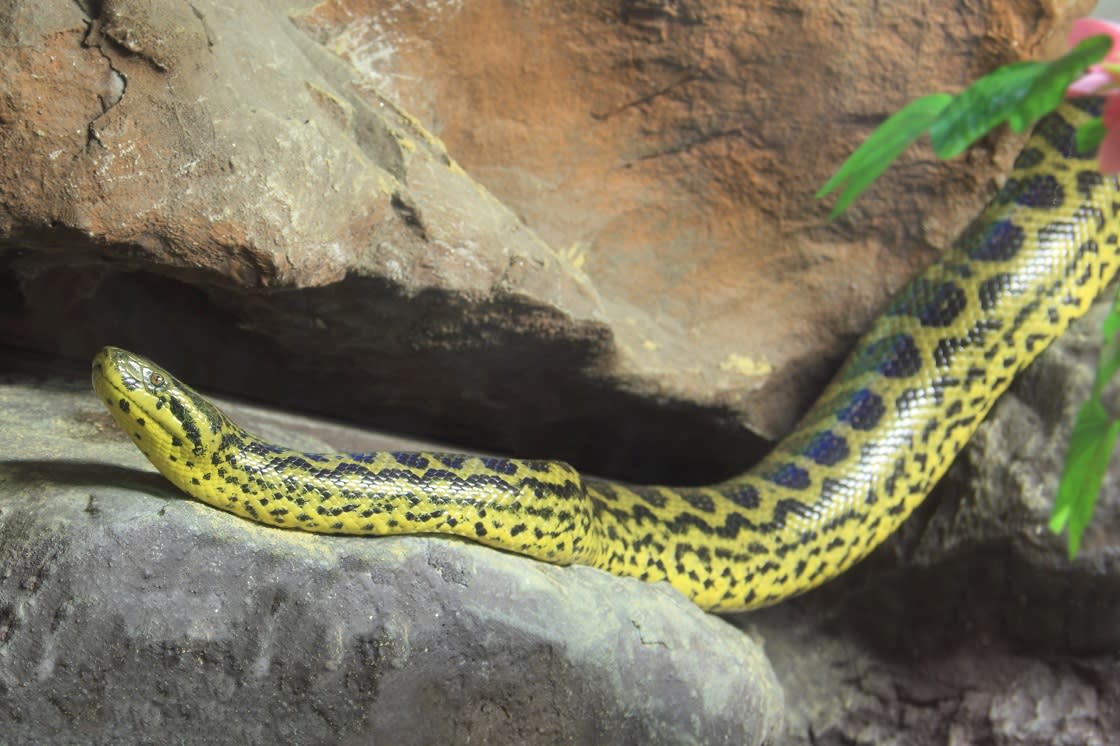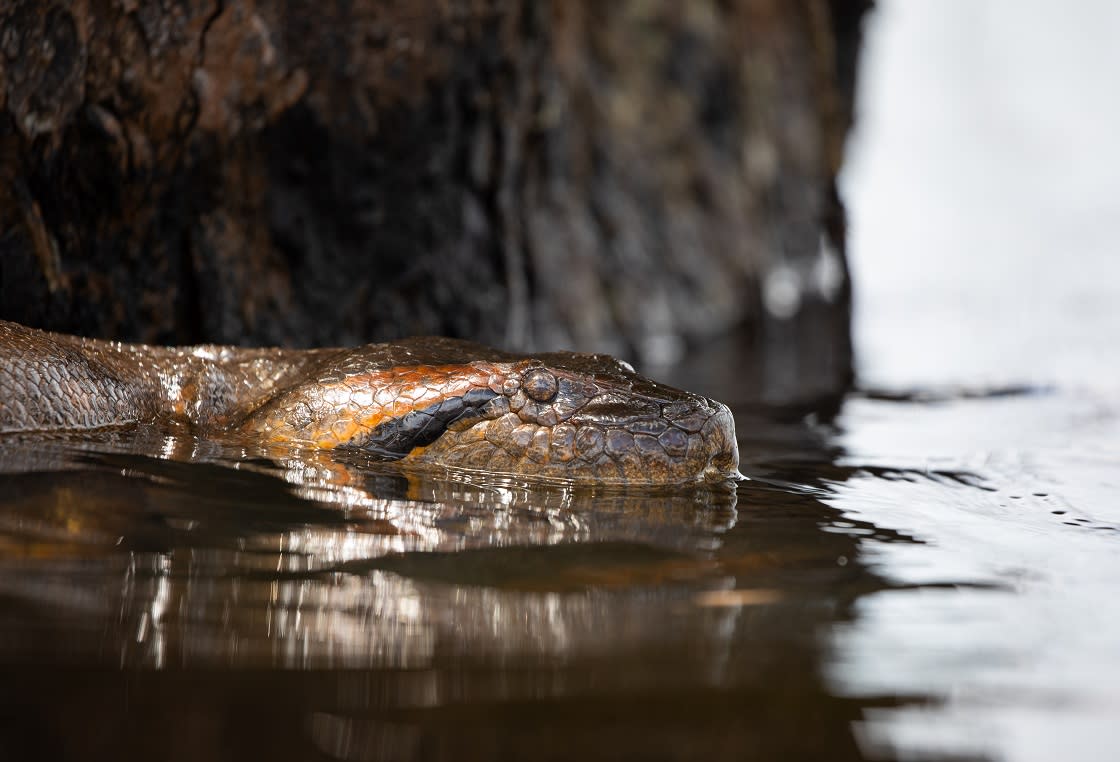
The Anaconda is a well-known species in today’s culture. Movies, books, and the internet boast the dangers of this “monster-like” snake. But are all of these rumors true? You might be wondering if you’ll stumble upon the Anaconda snake during a trip to the Amazon. Before you hesitantly pack your bags to the Amazon jungle though, here are a few surprising Anaconda facts you should know:
The name Anaconda (Eunectes) snake refers to a group of snakes found in the tropical regions of South America. Four species are currently recognized by the name, Eunectes, which means good swimmer. The Green Anaconda (Eunectes murinus) is the most well-known of these four species, and it is usually what comes to mind when you picture the large snake. In fact, it is the largest of the Anaconda family!

Green Anaconda (Eunectes murinus) seen in the Cuyabeno Wildlife Reserve
Many legends and lore circulate around the length of the Giant Anaconda. The Green Anaconda, or Eunectes murinus, is the heaviest, largest, and longest snake in South America. The Python still takes the title of the world’s longest snake, but in terms of diameter and weight, the anaconda is not only the largest in South America and the Amazon rainforest but also the world. The heaviest and longest anaconda ever recorded weighed a whopping 500 lbs (227 kilograms) and measured a monster 27.7 feet (8.43 meters) in length, with diameter of 44 inches (1.11 meters)!
During the days of President Teddy Roosevelt, the Wildlife Conservation Society offered a $50,000 reward to anyone who could deliver a live snake measuring over 30 feet in length. The offer was thankfully terminated in 2002 to discourage people from disturbing these animals from their natural habitats. A shame for the Brazilian construction workers who supposedly encountered a 33-foot anaconda in 2016 in a cave in Brazil’s northern state of Para, although this was never officially recorded or verified.

Yellow Anaconda (Eunectes notaeus)
The smallest species of Anaconda, the Yellow Anaconda (Eunectes notaeus) measures to be 3-4 meters in length (that’s still quite a large snake!). The females grow larger than the males and both live in aquatic habitats. While out on an Amazon jungle walk, keep an eye out for swamps and marshes, maybe you will be lucky enough to see an Anaconda snake peeking through!

Bolivian Anaconda (Eunectes beniensis)
The other two species of Anacondas, the Dark-Spotted Anaconda (Eunectes deschauenseei) and the Bolivian Anaconda (Eunectes beniensis), are quite rare, and little is known about them, though they both have estimated measurements of 15-16 (approx. 5 meters) feet in length. As the name suggests, the Bolivian Anaconda can be found in the Bolivian Amazon rainforest while the Dark-Spotted Anaconda roams around the Brazilian Amazon.
False. The unofficial species is supposed to be able to exceed 40-60 feet in length and is reportedly rarely seen. Unfortunately, (or perhaps, fortunately), this snake of mythical proportions isn’t real. At least, its existence has never been verified. There used to be a now extinct species of enormous snake known as the “Titan Boa”, Titanoboa cerrejonensis, whose fossilized remains were found in 2009 in Colombia. This particular example measured 42-feet in length and is estimated to have weighed some 2,500 pounds. It would have closely resembled the Anaconda in appearance and shared a similar habitat, so it is not unfathomable (just highly unlikely) that some of the “Giant Anaconda” sightings were actually just extraordinary extant Titan Boa sightings.
The Anaconda has been given a bad reputation over the years of being a “man-eater”, as a result of movies and media. Even in Amazonian folklore, the Giant Anaconda snake is called an “Encantado,” a shapeshifting mythical creature known for kidnapping humans they fall in love with. While there have been claims and fake photos of Anacondas eating humans, it is unverified, and most definitely not true. There was some stir recently over a Discovery Channel special called, “Eaten Alive”, where a naturalist wearing a snake-proof suit was supposed to be eaten by a Green Anaconda. The Anaconda wasn’t prone to eat the naturalist at all, was frightened, and tried to escape. The Anaconda only attacked him after much provocation. Many people turned to Social Media to express their outrage at this irresponsible stunt, criticizing Discovery Channel for airing something so completely out of scientific nature that would cause harm to the animal.
That being said, while an encounter with an Anaconda snake could be dangerous, it is highly improbable that the Anaconda would try to hunt or eat you.

The majority of a Green Anaconda’s prey are fish, birds, and small mammals
So, what do Anacondas eat? When it comes to the Amazon food chain, all four Anaconda species are practically on top, with their only predators being the occasional Caiman or Jaguar. The majority of a Green Anaconda’s prey are fish, birds, and small mammals which venture too close towards the water’s edge. They occasionally eat other reptiles as well, including other Anacondas! The reason for cannibalism among the species isn’t quite understood, other than it usually takes place when a larger female eats a smaller male – that’s nature for you! It is also true that Green Anacondas are capable of eating larger animals such as Capybaras, Tapirs, and even Caimans, though they tend not to do so on a regular basis. The Yellow Anaconda’s diet consists of the same foods as its larger cousin, but it also has a taste for birds’ eggs and fish carrion. It’s safe to say the Jaguar has competition for its King of the Jungle title.
Nope! All four species of Anaconda aren’t venomous and instead use constriction to subdue their prey. When an Anaconda sees its prey come down to the water’s edge, it will swim quickly but quietly towards it, keeping just out of sight. When the time is right, an Anaconda will strike, using its immensely muscular body, and constrict the animal until the unlucky victim dies of asphyxiation. One of the more talked about anaconda facts that are true is how an Anaconda is able to then “unhinge” its jaws in order to swallow such large prey. The reason an Anaconda is capable of managing such a feat is that its lower jaw isn’t fused to its skull. This makes for one enormous bite. After a meal the size of a large mammal, an Anaconda will not need to eat again for months.

Orinoco River in Venezuela
All four species of Anaconda can be found throughout South America, but they dwell predominately in the Amazon and Orinoco river basins. Anacondas are semi-aquatic and thrive in slow-moving streams, rivers, and other muddy, marshy environments – a trait which means those aboard Amazon river cruises or Pantanal tours that explore their preferred habitat are sometimes graced with once-in-a-lifetime encounters with them.
These “Water Boas”, as Anacondas are sometimes called, tend to be slow and unwieldy while on land, and instead use their sleek bodies to swim swiftly through the water. Anacondas are primarily nocturnal snakes, though can be seen as active throughout the day. An interesting Anaconda fact is that their eyes and nasal openings are higher up on their head than most snakes. This nifty feature allows for them to stalk their prey while staying nearly submerged beneath the water’s surface.

Anaconda In The River
Anacondas are solitary snakes and only get together during the mating season which takes place between April and May. During this time the snakes will group together in odd clusters known as “breeding balls”, where up to twelve males will try to mate with one female. These “slow-motion wrestling matches” can last for over four weeks at a time!
A female Green Anaconda can give birth to 60-100 live young. Baby Anacondas are only two feet in length and receive no maternal nurturing growing up. Over the next few years, the Anacondas will grow to immense proportions until they reach adulthood, at which point their rate of growth will drastically decrease. All four species of Anaconda have a lifespan of about 10 years in the wild. During this decade of their life, these snakes will grow to become one of the largest and most iconic in the world. Dangerous – but fascinating – the Anaconda is sure to be one snake you won’t forget in a hurry.
While Rainforest Cruises aim to provide accurate and up-to-date information, we make no representations as to the accuracy or completeness of any information herein or found by following any link on this site. Rainforest Cruises cannot and will not accept responsibility for any omissions or inaccuracies, or for any consequences arising therefrom, including any losses, injuries, or damages resulting from the display or use of this information.




